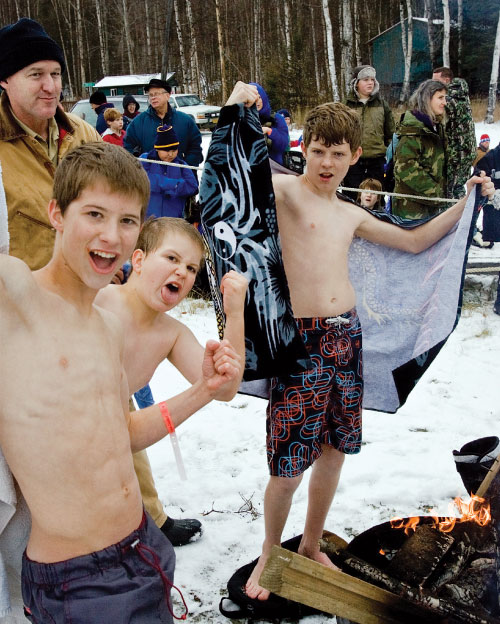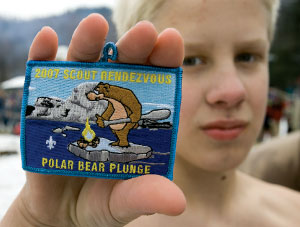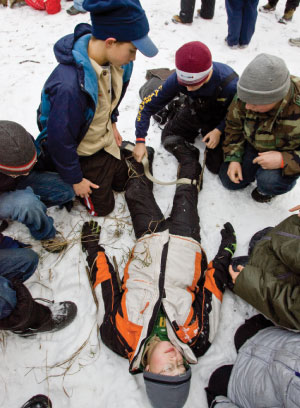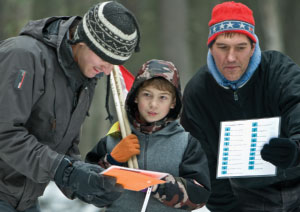Deep Freeze
By Cindy Ross
Photographs by John R. Fulton Jr.
How low did the temperature go when Scouts from the Midnight Sun Council went swimming in Lost Lake to earn their Polar Bear patch? Finding out will give you the shivers.
 After plunging into the frigid waters of Lost Lake, Troop 5 Scouts Bryce Nichols, Bryan Nichols, and John Moser (from left), feel as if they can conquer anything. |
Five Scouts stood shivering beside a freezing lake in the Alaskan interior. They wore nothing but Hawaiian-print swim trunks and felt-packed Arctic boots. Their bare bellies shone pale white, like halibut.
Along the shore, makeshift campfires burned in fire barrels, and steam rose from hanging pots that contained hot chocolate. Parents, poised with towels, stood ready to wrap their wet, chilled Scouts.
In Alaska, where summers are short, you have to get into the water whenever the opportunity presents itself. So a little cold weather doesn’t stop an Alaskan Scout from going for a dip. After all, they’re great charity fundraisers.
 David Wessner of Troop 47 looks as cool as ice with his patch. |
Scouts from Alaska’s Midnight Sun Council put its Polar Bear Swim on the agenda for their Autumn Camporee at Lost Lake, about 60 miles southeast of Fairbanks — in part so they’d have the opportunity to earn a Polar Bear patch.
Understand that October might mean autumn in many parts of the United States. But winter had arrived weeks ago in Alaska. The night before the swim, temperatures had dipped to 8 degrees, and by 1 in the afternoon, the so-called “heat of the day,” the mercury had barely risen out of the teens.
Cliff Crismore, the council’s Scout executive, explained the rules: “You must go in at least to your armpits. You have to look wet, like you took a shower … or you won’t get your patch.”
To keep everyone safe, a certified diver, decked out in a thermal dry suit, stood watch as wave after wave of swimmers took the plunge.
“The first five have to be real tough so they don’t scare the rest away,” explained Chris Benshoof, camporee program chair for the council. Scouts gave the icy experience mixed reviews.
“The cold water sucked all the wind out of me,” said James Leader of Troop 1, chartered to Fairbanks Rotary.
“It felt like being trapped under an iceberg,” added Tom White of Troop 42, North Pole.
Several other Scouts loved it. Shawn Combs went in twice. Jesse Bennett swam five times. “I love to swim,” Jesse said. “I can’t get enough.”
Before it was over, nearly 100 Scouts had taken the plunge along with their leaders and their parents.
 Ice the wound: Michael Balko of Troop 38 plays the victim in a first-aid drill. |
“It’s a unique opportunity,” Crismore said. “The Scouts can tell their friends about it. They can entice others to come out and join Scouting. The patch is something they can wear and be proud of.
“It’s what we do for entertainment up here in Alaska,” he said, chuckling. “We’re a different breed.”
Weather or not
The life of a Boy Scout in Alaska is different.
They wear handmade beaver hats and sleep in double sleeping bags. They put caribou meat in their spaghetti sauce and stash their toothbrushes and toothpaste in trees at night, away from the bears. They spray foam insulation around their water bottles to prevent the liquid from freezing. They hike on glaciers. And they maintain vigilance when they get up in the night to relieve themselves — in case they bump into a moose.
“The uniqueness here is the cold,” Crismore said. “Everything a Scout does in the Lower 48, we do, too. But Scouting doesn’t stop in Alaska just because the comfortable weather does. In a land where winter lasts eight months, and the sun may not shine for months at a time, that would be a lot of good times lost.”
Know before it snows
To help them enjoy those good times safely, the 200 Scouts visited 18 different skills stations located across the 400-acre Lost Lake camp all through Saturday.
At the wildlife station, they learned about bears — their habits, behavior, and safety — to help them with an outdoors environment where bears outnumber humans 10 to 1.
At another station, Scouts learned lessons in first aid, tending the simulated injuries of a Scout who lay limp in the snow. Christian Campbell of Troop 5, chartered to the Fairbanks 5th Ward, had ostensibly fallen out of tree while moose hunting. To heighten the seriousness of his staged predicament, a snow machine (they aren’t called snowmobiles in Alaska) had run over him.
At the firesafety station, experts taught Scouts the importance of not just using fire for warmth but also to melt snow for water and as a signaling device.
 Christian Balko (center) of Pack 38 tries to avoid sending mixed signals during a semaphore communications exercise with Nick Ferree (left) and his dad, Jim Balko. |
“If you are lost out here,” firefighter chief Russ Toms explained, “the first thing you need to know is how to start a fire.”
Every Alaskan Scout carries a survival backpack when camping in the woods. The Lost Lake Scouts learned that its contents should include a glow stick, nails to tie off ropes, and dry clothing in case they fall into an iced-over river.
“In Alaska, we must make sure they know these skills,” Toms said. “It is easy to get off the route and get lost in this state, so it’s very important to be self-sufficient.”
Elsewhere, blindfolded Scouts fumbled as they tried to set up a tent. “Darkness is a big issue,” Michael Walsh said. “If it’s Alaska, and it’s supremely dark, you have to know how to do this.” And at the shooting skills station, Scouts learned proper ways to handle a rifle.
“Guns are a big part of Alaskan life, and 90 percent of these dads hunt,” explained John Ferree, camporee chairman.
Alaskans live at the end of the road for a reason. Their pioneering spirit lives on here in the western hemisphere’s “final frontier.” And Scouting remains a terrific venue for teaching them the skills they need to survive.
That’s a job the Midnight Sun Council takes seriously — with a little bit of silliness like the Polar Bear Swim thrown in.
Freelance writer Cindy Ross lives in New Ringgold, Pa.
Extreme ScoutingThe Midnight Sun Council is home to 28 Scout troops in an area that covers two-thirds of the state — a phenomenal accomplishment, considering that Alaska is one-fifth the size of the entire Lower 48 states. Then, there’s the weather. A Scout living in the Alaskan interior considers 8 degrees “warm-weather camping.” In winter, temperatures can approach minus 40 to minus 60 degrees. That’s when even Arctic-insulated tents don’t work well. Condensation gathers on the walls, and every time you touch the fabric, it snows inside. So Scouts cut snow blocks with saws and build igloos. A single tea candle can keep the inside a relatively balmy 28 degrees. They also heap together wet snow and build natural Quonset huts, with connecting rooms and tunnels. Many Alaskan Scouts look forward to the cold and even celebrate it with the Minus 100 patch. For every degree the thermometer drops below freezing while they sleep outdoors, the Scouts receive one point. Scouts eventually accumulated so many points in a single winter that the Midnight Sun Council created Minus 200, then Minus 300 patches. Acquiring enough cold-weather gear presents difficulties for some Alaskan troops, though purchasing Army surplus helps. Typically, young Scouts camp in cabins until they are old enough to accumulate the necessary equipment. Especially, we suspect, hand- and foot-warmers. |